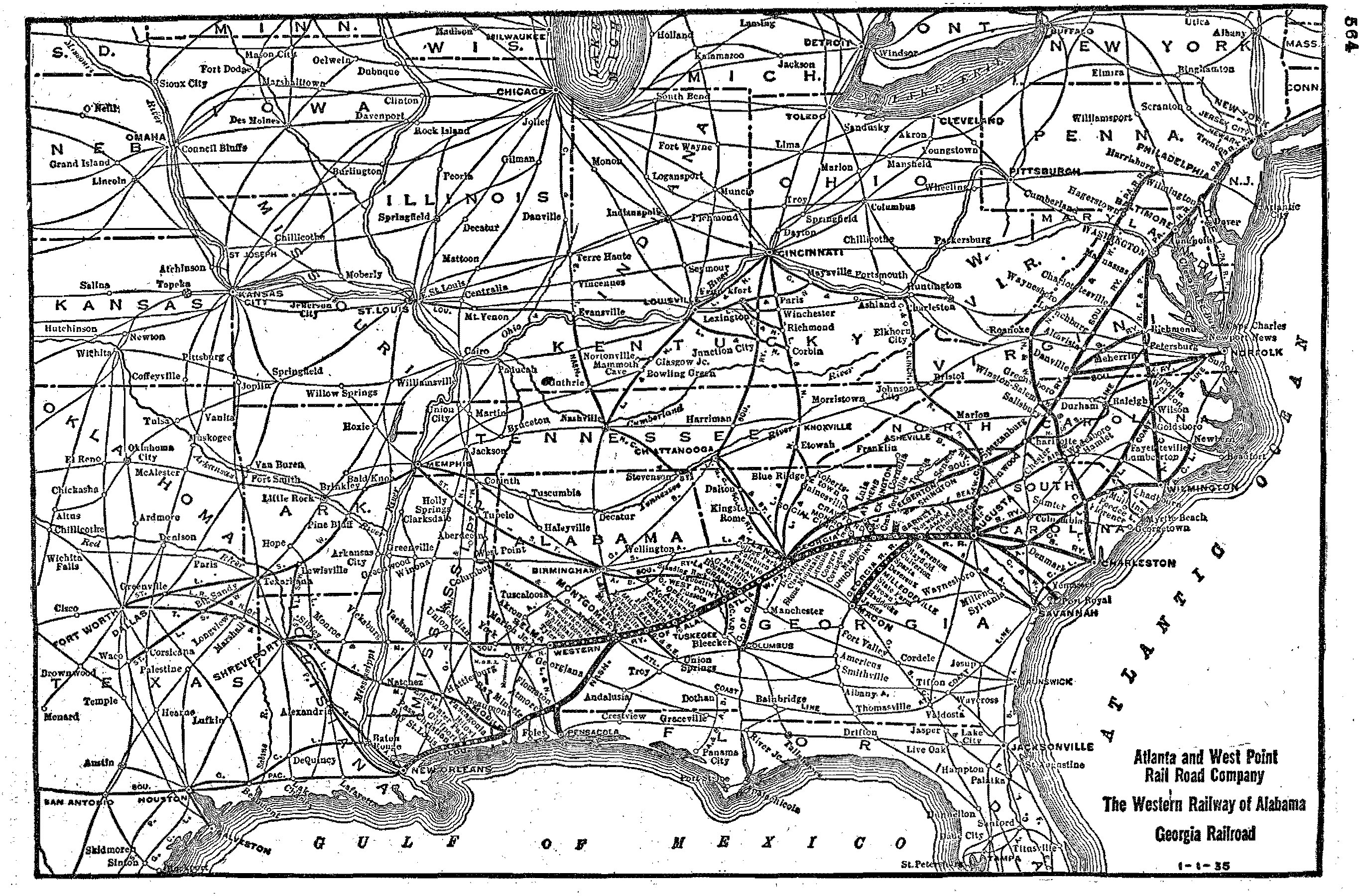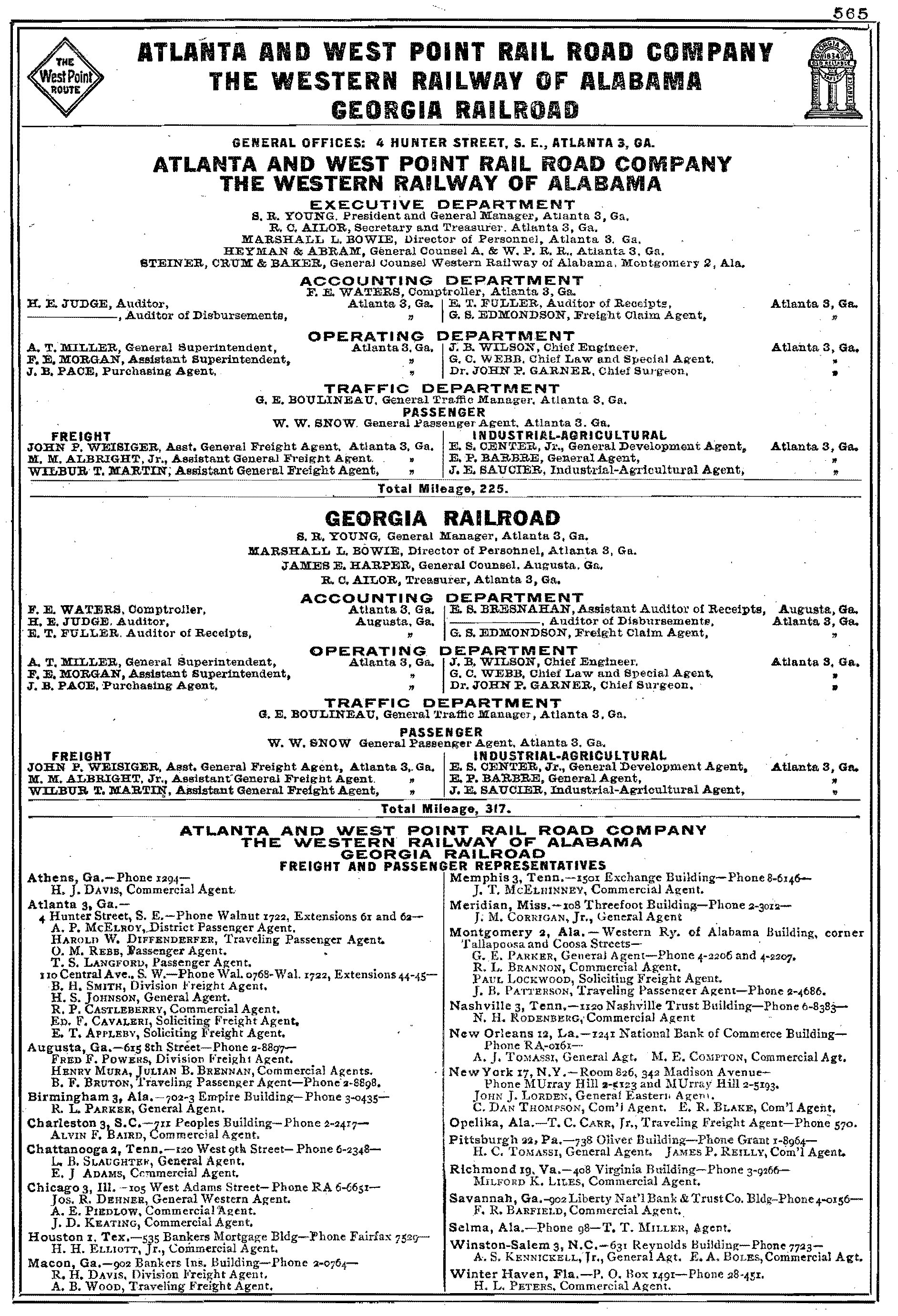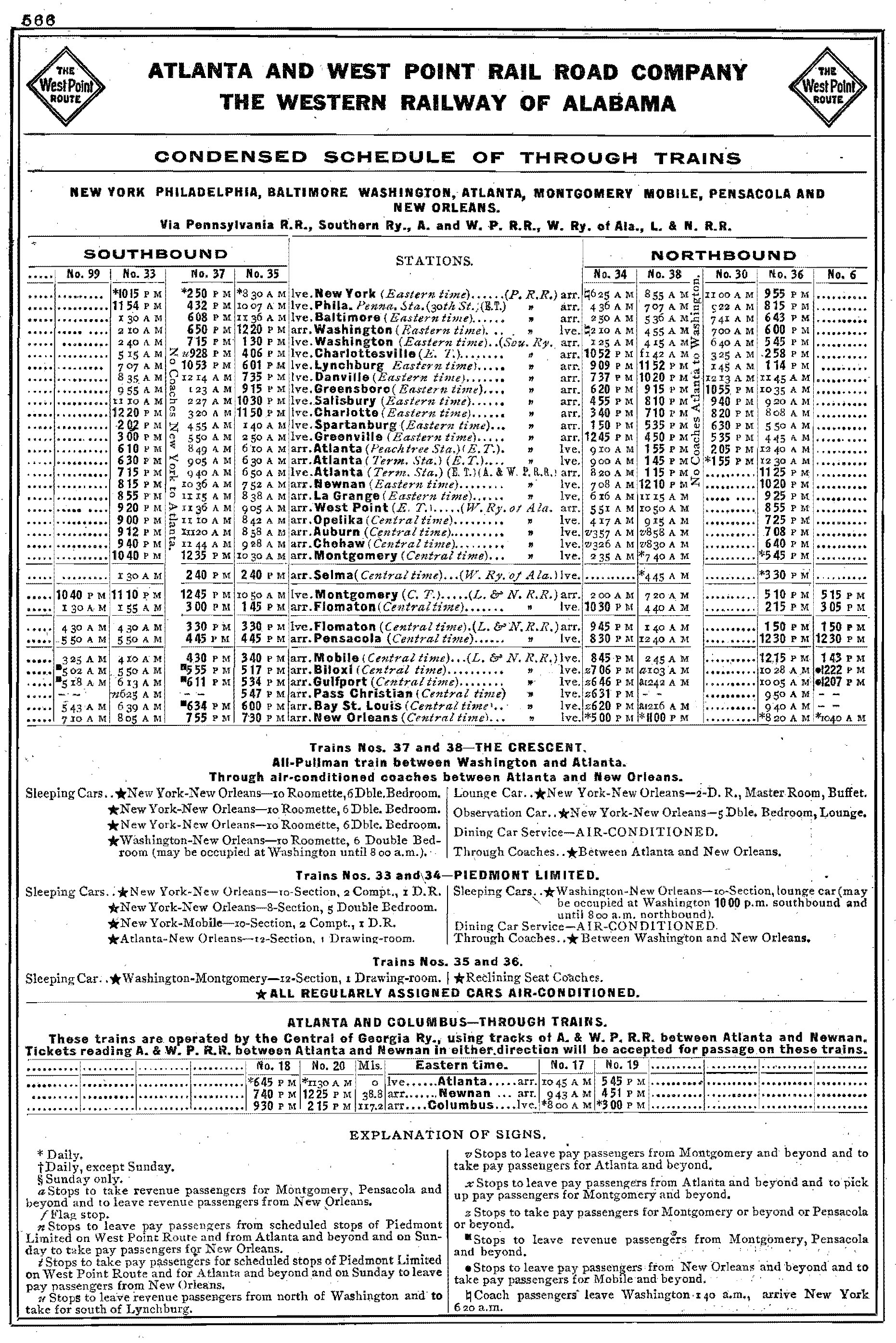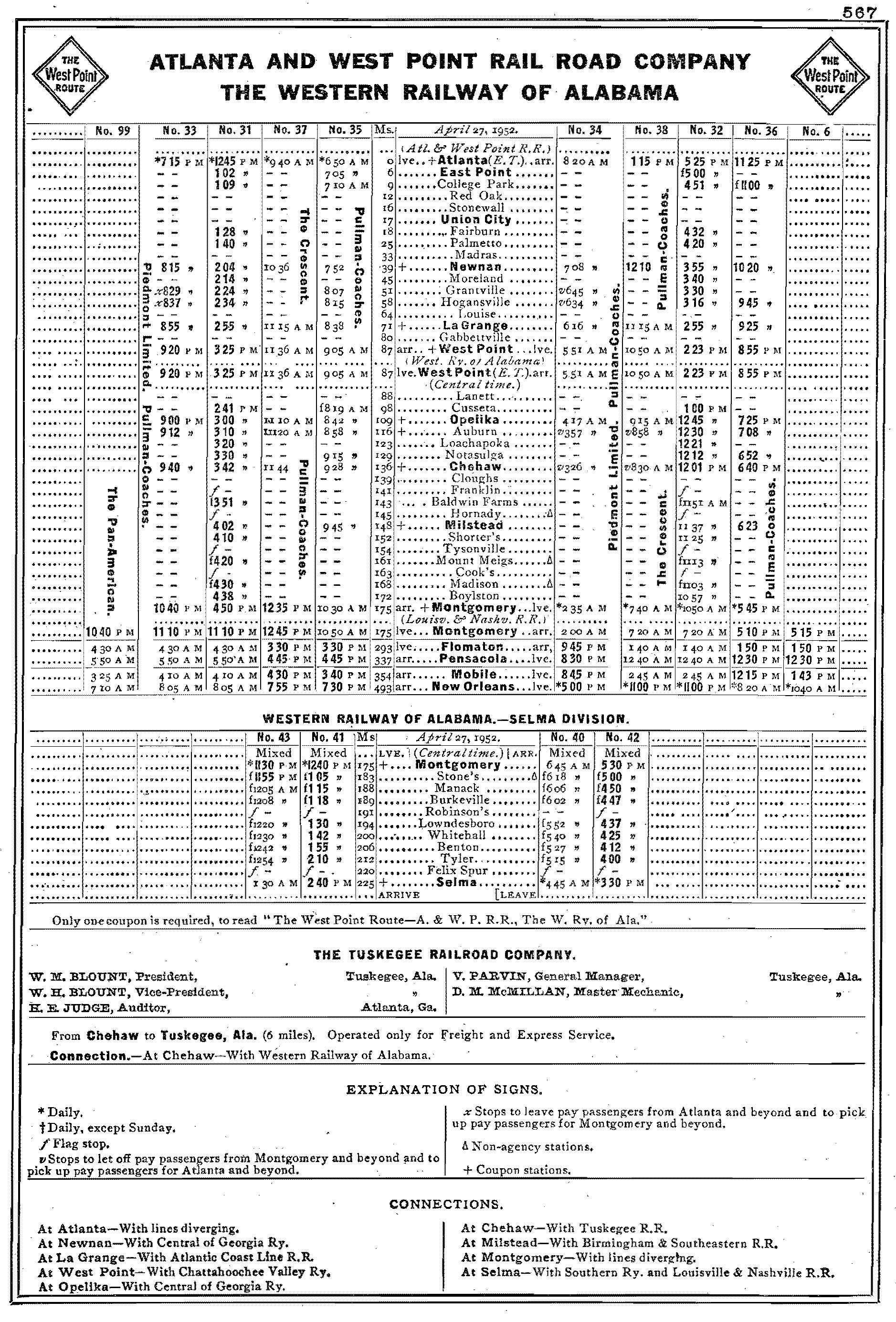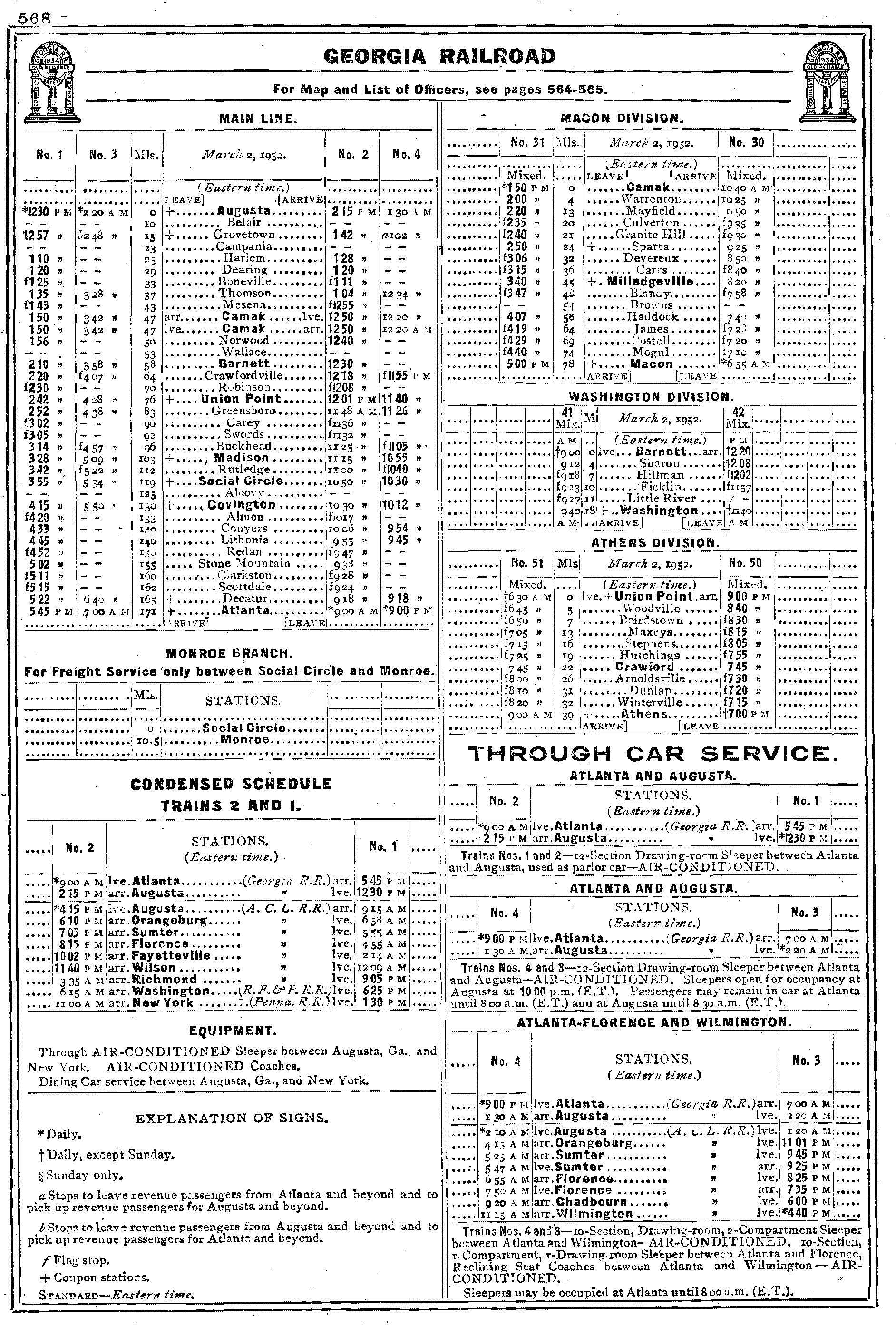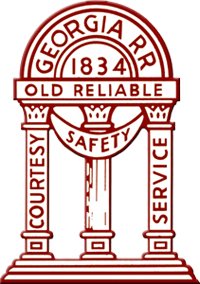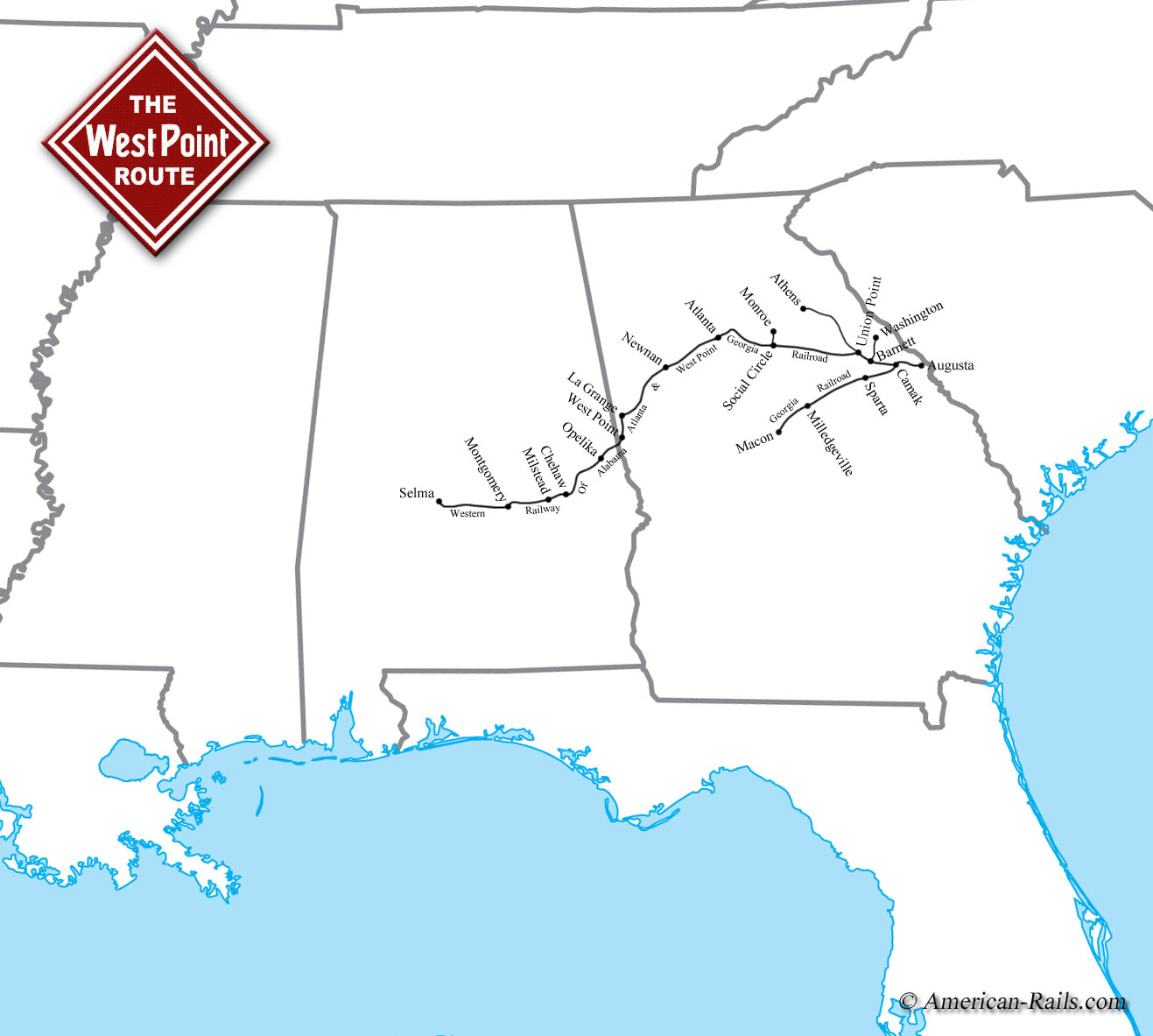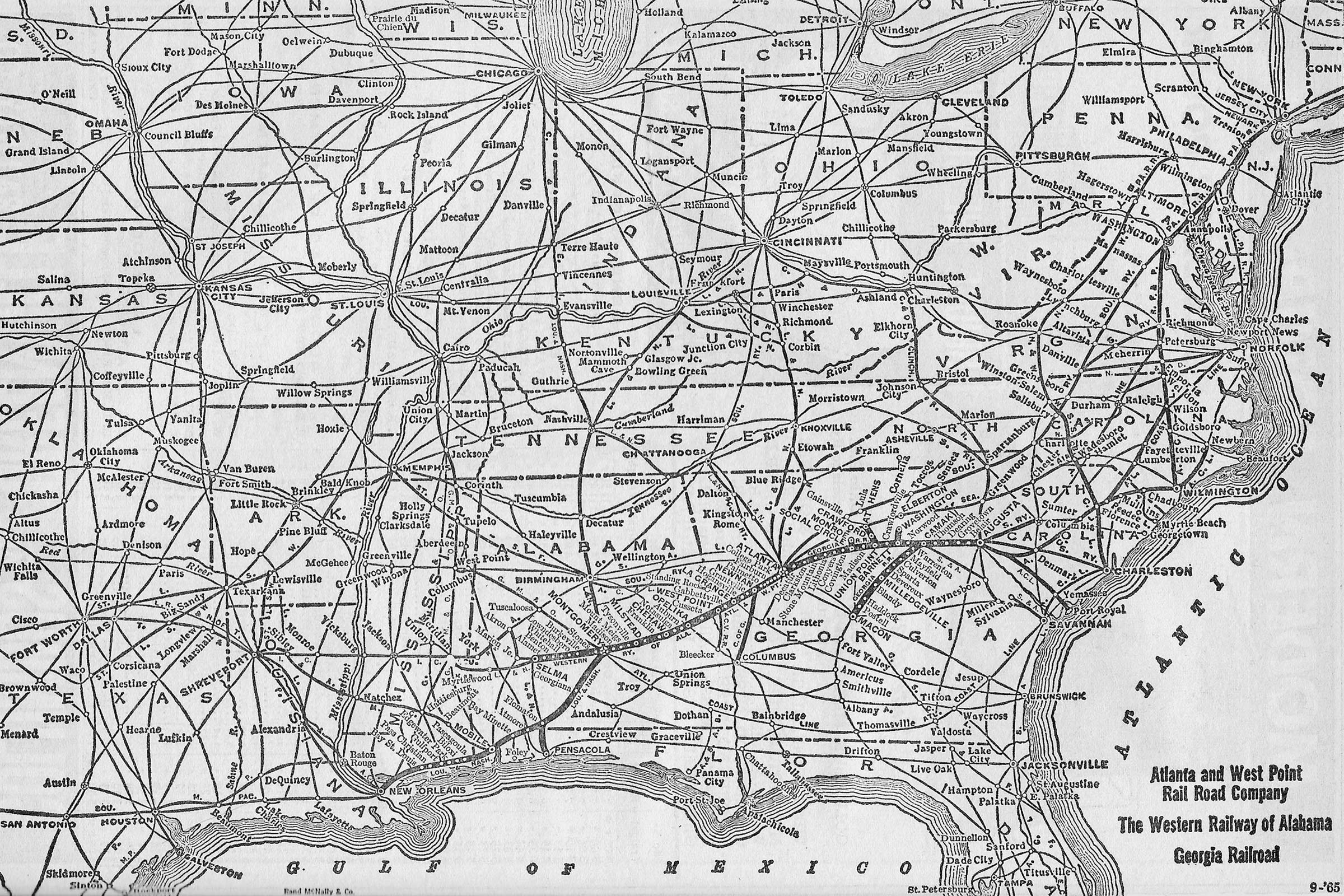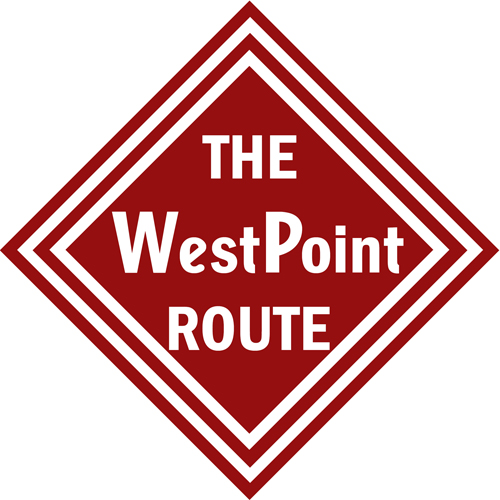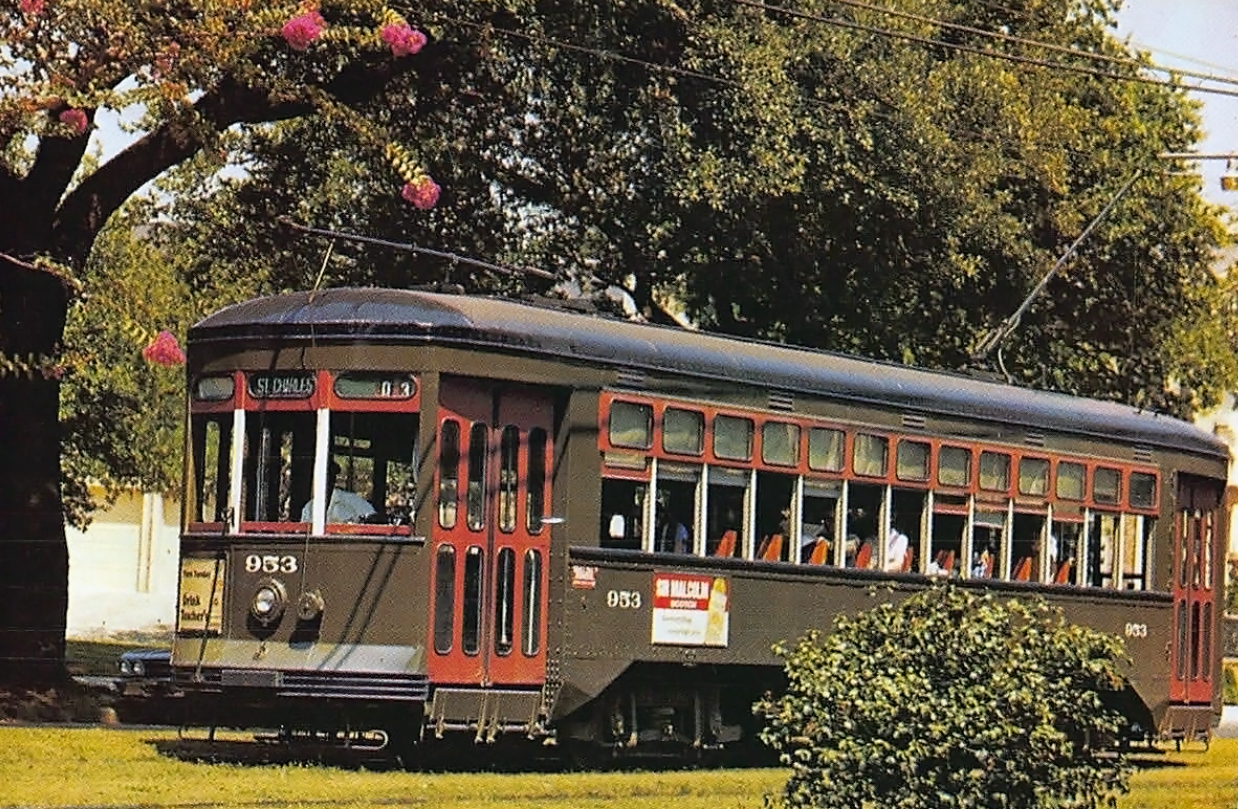West Point Route (Railroad): Map, History, Logo
Last revised: August 23, 2024
By: Adam Burns
The West Point Route was a fondly remembered southern system which connected Atlanta with Montgomery, Alabama.
The name itself was actually a marketing term only used by the Atlanta & West Point (A&WP) and Western
Railway of Alabama (WRoA).
The two companies met at West Point, Georgia and for many years were under the Georgia Railroad & Banking Company's control, which connected Atlanta with Augusta and Macon.
All three got their start handling agricultural-related traffic, transitioned to manufacturing and merchandise, and then spent later years as successful bridge lines.
From an early period they were jointly owned by the Louisville & Nashville and Atlantic Coast Line, remaining subsidiaries until the 1980's.
History
During a flurry of mergers beginning in the 1960's their identity slowly disappeared. First, the Seaboard Coast Line was created and then all railroads under SCL's control fell under the marketing name, "Family Lines System."
Finally, they vanished into the Seaboard System and CSX Transportation. Today, the West Point Route continues to play an important role under CSX.
Photos
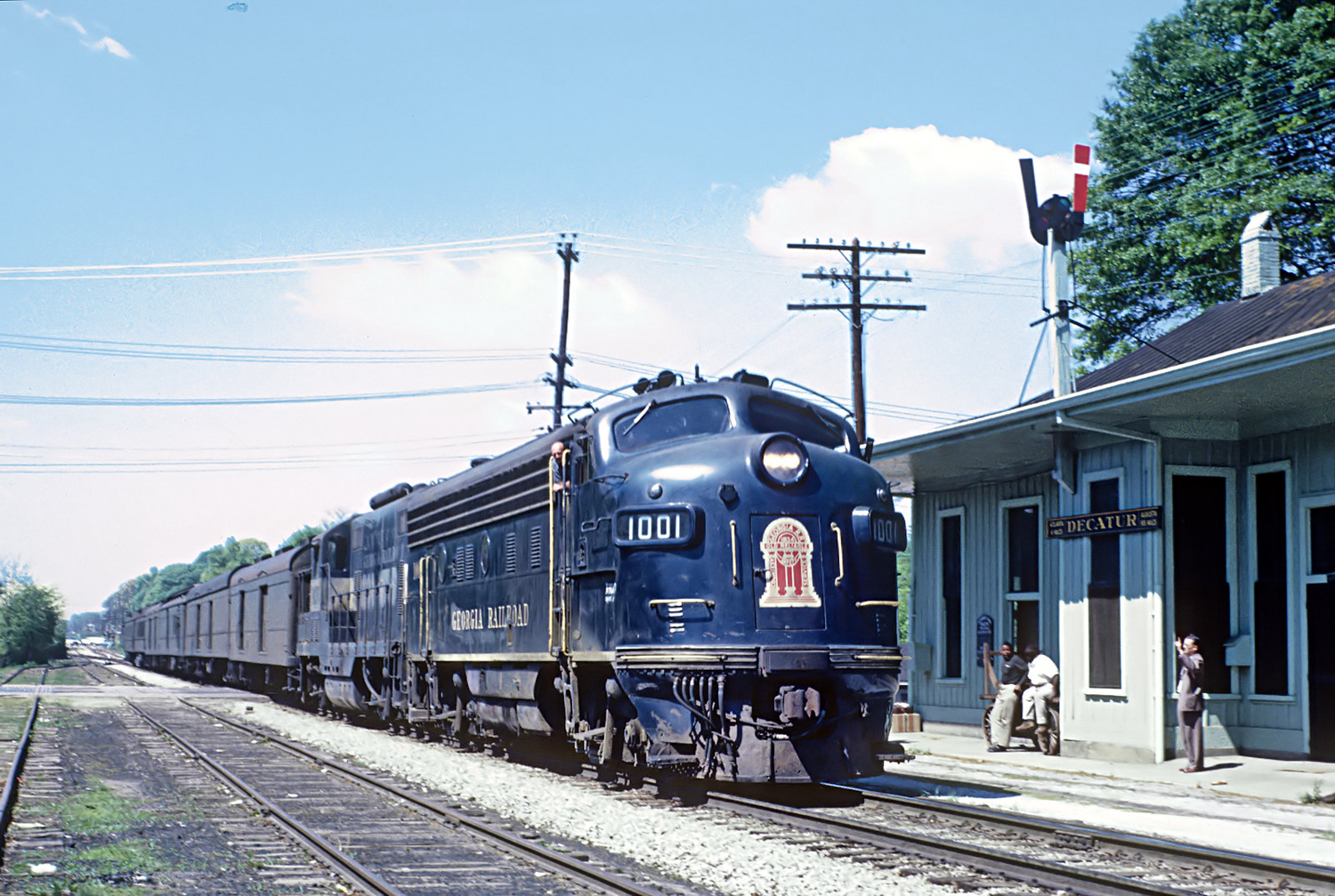 Georgia Railroad F3A #1001 wears a new paint scheme as it arrives in Decatur, Georgia with train #2 on April 13, 1963. Roger Puta photo.
Georgia Railroad F3A #1001 wears a new paint scheme as it arrives in Decatur, Georgia with train #2 on April 13, 1963. Roger Puta photo.Georgia Railroad
The history of the West Point Route is one of struggle, perseverance, and eventual success. The Georgia Railroad was technically not part of the West Point Route although as the long-time owner a brief history will be provided here.
Its ancestry begins on December 21, 1833 when the Georgia Railroad Company was chartered to build a new line from Augusta to Athens. Only a day earlier the Central Rail Road & Canal Company had been born through Savannah interests to construct their own line westward towards Augusta.
In time this future rival became the Central of Georgia Railway and blossomed into a profitable 1,500+ mile network connecting Savannah, Atlanta, Athens, Chattanooga, Montgomery, Birmingham, and other points.
At Augusta, construction of the Georgia Railroad began in 1835 and only a year later the corporate name was changed to the Georgia Rail Road & Banking Company. During December of 1841 the original route to Athens opened, built to the South's standard 5-foot broad gauge.
Timetables (1952)
Expansion
It was not long before a westward extension towards Atlanta was eyed. This new city literally grew from nothing. It all began with the Western & Atlantic's chartering in late 1836 to connect Decatur with Chattanooga, Tennessee.
Surprisingly, the former town did not want a railroad and so the W&A's southern terminus was moved a few miles to the southwest at a location known simply as "Terminus."
It became Marthasville in 1843 (according to Dain Schult's book, "Nashville, Chattanooga & St. Louis: A History Of 'The Dixie Line'," the town was named after former Georgia governor Wilson Lumpkin's daughter, Martha) and then Atlanta in 1847.
In 1845 the Georgia Railroad opened its own line to the town, followed by the Macon & Western (Central of Georgia) on September 4, 1846. In short order the railroad was a financial success and one of the South's better systems entering the Civil War.
It suffered considerable damage by Union forces during the conflict's latter years, particularly during General Sherman's "March To The Sea." Afterwards the line was quickly rebuilt and before long was again expanding. In 1867 it leased the Macon & Augusta which was attempting to complete a connection with the Georgia at Warrenton.
The 78-mile branch was finished in 1873 and established through service from Camak, along the Georgia's main line, to Macon. This was largely the extent of the Georgia's system. Further growth came through acquisition.
As Richard Prince's book, "Central of Georgia Railway And Connecting Lines" notes, in 1875 the Georgia Rail Road & Banking Company, in conjunction with the Central Rail Road & Banking Company Of Georgia, jointly leased the Western Rail Road of Alabama.
This system offered through service to Montgomery and Selma, Alabama via West Point where interchange was carried out with the Atlanta & West Point (the A&WP was already a Georgia Railroad subsidiary). It was then reorganized as the Western Railway of Alabama and remained a partnership venture for nearly twenty years.
In 1881 half the Georgia and its subsidiaries were leased to the Louisville & Nashville while the Central Rail Road & Banking Company Of Georgia picked up the other half.
During the Panic of 1893 the Central failed, which allowed the L&N to acquire its half-interest. In 1902 the Atlantic Coast Line took control of the L&N and from that point forward the Georgia remained a subsidiary of much larger railroads.
Western Railway Of Alabama
The Western Railway of Alabama (WRoA) traces its heritage back to the Montgomery Rail Road Company chartered on January 15, 1834.
Robert Hanson's book, "The West Point Route," points out that it was envisioned to construct a new line from Montgomery to just across the Georgia state line at West Point along the Chattahoochee River.
During 1835 and into 1836 the line's survey work was completed while actual construction commenced on March 1, 1836. In June of 1840 the first 32-mile section opened from Montgomery to Franklin.
Almost immediately the railroad ran into trouble as it struggled to earn sufficient revenue to cover expenses. It was subsequently sold at foreclosure on July 9, 1842 and a new company chartered on February 13, 1843.
Known as the Montgomery & West Point Rail Road (M&WP), at first it too experienced difficulties as it attempted to corral funding for the line's completion.
Eventually, these efforts paid off with rails opening to Opelika in 1848 and finally West Point on April 28, 1851. The latter town became the interchange point with the Atlanta & LaGrange, predecessor to the Atlanta & West Point, when it reached there in 1854.
Little additional growth occurred although it did add one notable branch, a 29-mile extension from Opelika to Columbus, Georgia which opened in 1855.
The railroad was spared the worst of the Civil War until July of 1864 when it was damaged by Union forces between Opelika and Chehaw as well as along its Columbus Branch.
More extensive destruction was carried out in April of 1865. After the war M&WP forces worked quickly on repairs and finally had the entire railroad back in service by August 29th that year.
They also re-gauged the property from 4 feet, 8 1/2 inches to 5 feet. On September 1, 1870 the M&WP merged with the Western Rail Road to form the Western Rail Road Company of Alabama.
Just a few months later, in December, rails were pushed westward from Montgomery to Selma. Financial trouble found the road following the Panic of 1873 and it failed on April 1, 1874. A year later, on June 1, 1875, it was taken over in a joint agreement between the Central Rail Road & Banking Company Of Georgia and Georgia Railroad & Banking Company.
In corporate maneuverings carried out by the new owners the Columbus Branch was acquired by the Central Rail Road and the Western Railway of Alabama was chartered on March 15, 1883 to operate the assets of the Western Rail Road Company Of Alabama.
The use of broad gauge throughout the South lost its luster by century's end as railroad after railroad switched to the standard width of 4 feet 8 1/2 inches. The WRoA at first changed to 4 feet, 9 inches in the spring of 1886 and then soon afterwards reduced this by a half-inch more.
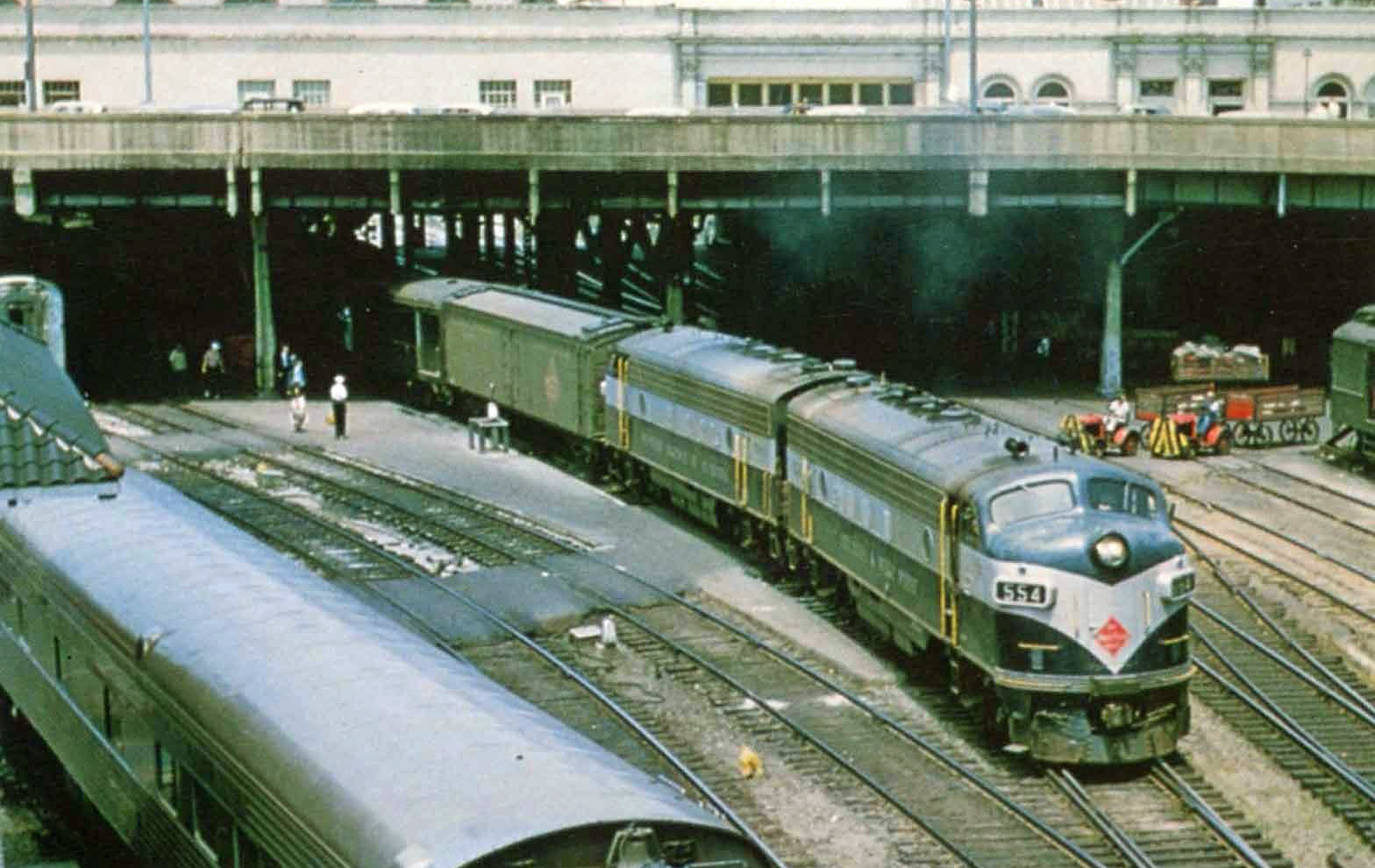 Atlanta & West Point (West Point Route) FP7 #554 departs Atlanta Terminal Station with Southern's "Crescent Limited" (New York-Washington-Atlanta-Montgomery-New Orleans) in 1957. Howard Robins photo.
Atlanta & West Point (West Point Route) FP7 #554 departs Atlanta Terminal Station with Southern's "Crescent Limited" (New York-Washington-Atlanta-Montgomery-New Orleans) in 1957. Howard Robins photo.Atlanta & West Point Railroad
The eastern component of the West Point Route was the Atlanta & West Point (A&WP). Its history begins on December 27, 1847 with the chartering of the Atlanta & LaGrange Rail Road.
The state stipulated it was to connect with the Macon & Western "somewhere near Atlanta" and run westward to the state line at LaGrange.
Built to 5-foot, broad gauge construction began during the fall of 1849 from the M&W connection at East Point and by March of 1851 had opened 18 miles to Palmetto.
By September, rails reached Newnan and just over a year later, in February of 1853, trains were rolling into LaGrange. The project had been largely funded by the Georgia Railroad & Banking Company and as a result it did not suffer from the financial shortfalls experienced by its western counterpart.
With an amendment to the charter it completed a final extension to West Point (80 miles in all) which provided a partial interchange with the Montgomery & West Point.
However, through service could not be established due to the gauge differences at that time. On December 22, 1857 a name change took place and the corporation became the Atlanta & West Point Rail Road.
System Map (1965)
Like the Montgomery & West Point the A&WP mostly avoided Union incursions until 1864 when General Sherman's advancing forces caused extensive damage to its network with losses totaling more than $1.6 million. Within short order, however, it too got back onto its feet and was reporting net earnings by 1866.
As mentioned above things remained unchanged from a corporate standpoint until the 1881 agreement whereby the Georgia and its subsidiaries were leased to the Louisville & Nashville and Central Rail Road & Banking Company Of Georgia.
With the Central's financial collapse following the Panic of 1893 the L&N acquired its half-interest. In 1902 the Atlantic Coast Line took control of the L&N. There remained a series of additional corporate changes to take place before the final, modern version of the West Point Route was born.
The first had occurred in March of 1883 when the WRoA and A&WP came under common management. For many years the two roads had used the marketing slogan "Atlanta and New Orleans Short Line" in an appeal to draw in potential new business. In 1896 they introduced the moniker within a diamond logo.
Another slight change took place in 1902 when it was changed to "The West Point Route." Just as the WRoA had done, the A&WP's gauge was changed from 5-foot broad gauge to 4 feet, 9 inches in the spring of 1886 and then soon afterwards reduced to 4 feet, 8 1/2 inches.
Logo
The West Point Route
Into the 20th century the 225-mile West Point Route (A&WP and WRoA) fared relatively well. Throughout the years passenger business played an important role although not necessarily always a profitable one. On May 14, 1905 the beautiful Atlanta Terminal Station opened, replacing an earlier facility that was cramped and outdated.
Prior to construction the project was originally owned by the Southern Railway and Central of Georgia through new subsidiary Atlanta Terminal Company created in early 1903. Before long, the Atlanta & West Point had also acquired a one-third interest and the three maintained joint-ownership until the facility was razed in the early 1970's.
At A Glance
317 (Georgia Railroad) 225 (Atlanta & West Point and Western Railway of Alabama) | |
Atlanta - Augusta, Georgia Augusta - Macon, Georgia Augusta - Athens, Georgia | |
The station was designed by P. Thornton Marye featuring two grand spires bracketing the headhouse. Over the years it also saw use by the Seaboard Air Line and Atlanta, Birmingham & Atlantic.
During the facility's peak years it witnessed more than eighty trains per day including such names as the Crescent, Man O'War, Ponce de Leon, and Nancy Hanks.
Into the 1920's the railroads acquired new locomotives and completed the installation of automatic block signals (1922), a project that helped improve freight business. Following the Great Depression and through the early 1930's the A&WP and WRoA struggled to remain solvent.
Prior to the market's collapse they netted a combined profit of more than a half-million dollars and then recorded losses of the same by 1932. Within a few years the roads had turned a corner and were showing a profit once more by 1936, having avoided bankruptcy.
By World War II business of all types was soaring which necessitated purchasing additional locomotives. In 1945 the roads reported a profit of more than $700,000.
As Joseph Sadler notes in his article, "West Point Route" from the June, 1943 issue of Trains Magazine freight business by this time was 90% through traffic with just 10% originating online. Diesels also arrived in the postwar years beginning in May of 1948 when F3A #501 was delivered to the WRoA.
New units continued to roll in until steam had been retired completely by July 1, 1954. Most power was from Electro-Motive but all three roads did purchase a few Baldwin switchers. The locomotives were clad in a striking livery of deep blue and silver with the "West Point Route" and Georgia Railroad logos adorning respective units.
Diesel Rosters
Atlanta & West Point
| Road Number(s) | Builder | Model | Amount | Date Built |
|---|---|---|---|---|
| 551-554 | EMD | FP7 | 4 | 1949-1951 |
| 1005 | EMD | FP7 | 1 | 1949 (Ex-WRoA #502) |
| 571-576 | EMD | GP7 | 6 | 1950-1952 |
| 675 | Baldwin | DS-4-4-1000 | 1 | 1949 (Ex-Georgia #921) |
| 676-677 | Baldwin | DS-4-4-1000 | 2 | 1949 |
| 678 | Baldwin | S-12 | 1 | 1951 |
| 726-732 | EMD | GP40 | 7 | 1967-1970 |
| 733 | EMD | GP40-2 | 1 | 1974 |
| 4976 | EMD | GP16 | 1 | 1950 (Ex-A&WP GP7 #576) |
| 4978 | EMD | GP16 | 1 | 1951 (Ex-ACL GP7 #246) |
| 6007-6008 | EMD | GP38-2 | 2 | 1979 |
Western Railway of Alabama
| Road Number(s) | Builder | Model | Amount | Date Built |
|---|---|---|---|---|
| 501 | EMD | F3A | 1 | 1948 |
| 502-503 | EMD | FP7 | 2 | 1949 |
| 520 | EMD | GP7 | 1 | 1950 (Ex-SAL #1734) |
| 521-526 | EMD | GP7 | 6 | 1950-1953 |
| 530-531 | EMD | GP9 | 1 | 1954 |
| 621-624 (1-4) | Baldwin | VO-1000 | 4 | 1944 |
| 630 | Baldwin | DS-4-4-1000 | 1 | 1948 |
| 701-707 | EMD | GP40 | 7 | 1967-1970 |
| 708 | EMD | GP40-2 | 1 | 1974 |
| 4977, 4979 | EMD | GP16 | 2 | 1951-1952 (Ex-WRoA #524, Ex-ACL GP7 #141) |
| 6045-6046 | EMD | GP38-2 | 2 | 1979 |
Georgia Railroad
| Road Number(s) | Builder | Model | Amount | Date Built |
|---|---|---|---|---|
| 751-754 | EMD | GP40 | 4 | 1967-1968 |
| 755-756 | EMD | GP40-2 | 2 | 1972 |
| 901-905 | EMD | NW2 | 5 | 1948-1949 |
| 906-907 | EMD | SW9 | 2 | 1951 |
| 921 | Baldwin | DS-4-4-1000 | 1 | 1949 |
| 1001 | EMD | F3A | 1 | 1948 |
| 1002-1004 | EMD | FP7 | 3 | 1949-1950 |
| 1005 | EMD | FP7 | 1 | 1949 (Ex-A&WP #551) |
| 1019-1020 | EMD | GP7 | 2 | 1950 (Ex-A&WP #571-572) |
| 1021-1036 | EMD | GP7 | 16 | 1950-1953 |
| 1040-1042 | EMD | GP9 | 3 | 1954 |
| 4975 | EMD | GP16 | 1 | 1954 (Ex-Georgia #1042) |
| 6009-6010 | EMD | GP38-2 | 2 | 1979 |
| 6051-6052 | EMD | GP38-2 | 2 | 1980 (Ex-SCL #6051-6052) |
Steam Rosters
Western Railway Of Alabama (As of 1943)
| Class | Road Number | Wheel Arrangement | Builder | Date Built |
|---|---|---|---|---|
| E | 100-104 | 0-6-0 | Rogers | 1907-1908 |
| E | 105 | 0-6-0 | Alco | 1910 |
| G | 115, 127 | 0-8-0 | Alco | 1918 |
| A | 128-130 | 4-6-0 | Rogers | 1904 |
| A | 131, 161 | 4-6-0 | Alco | 1911 |
| A | 175 | 4-6-0 | Rogers | 1903, Rebuilt in 1924. |
| P | 180, 190 | 4-6-2 | Lima | 1926 |
| M | 181, 185, 186 | 4-8-2 | Alco | 1924 |
| M | 187, 375-377 | 4-8-2 | Alco | 1924 |
| F | 378 | 2-8-2 | Lima | 1923 |
Atlanta & West Point (As of 1943)
| Class | Road Number | Wheel Arrangement | Builder | Date Built |
|---|---|---|---|---|
| E | 200-202 | 0-6-0 | Alco | 1912 |
| G | 215, 225-226 | 0-8-0 | Alco | 1918 |
| G | 228-229 | 0-8-0 | Alco | 1918 |
| A | 230 | 4-6-0 | Rogers | 1903-1907 |
| A | 261 | 4-6-0 | Rogers | 1906, Rebuilt 1924. |
| A | 273 | 4-6-0 | Rogers | 1899, Rebuilt 1924. |
| A | 275 | 4-6-0 | Rogers | 1900, Rebuilt 1924. |
| P | 290 | 4-6-2 | Lima | 1926 |
| P | 280-281 | 4-6-2 | Alco | 1913 |
| P | 350-351 | 4-6-2 | Alco | 1913 |
| F | 425-427 | 2-8-2 | Lima | 1923 |
| F | 400-401 | 2-8-2 | Lima | 1918 |
The above steam locomotive roster information is courtesy of Joseph Sadler's article, "West Point Route" from the June, 1943 issue of Trains Magazine.
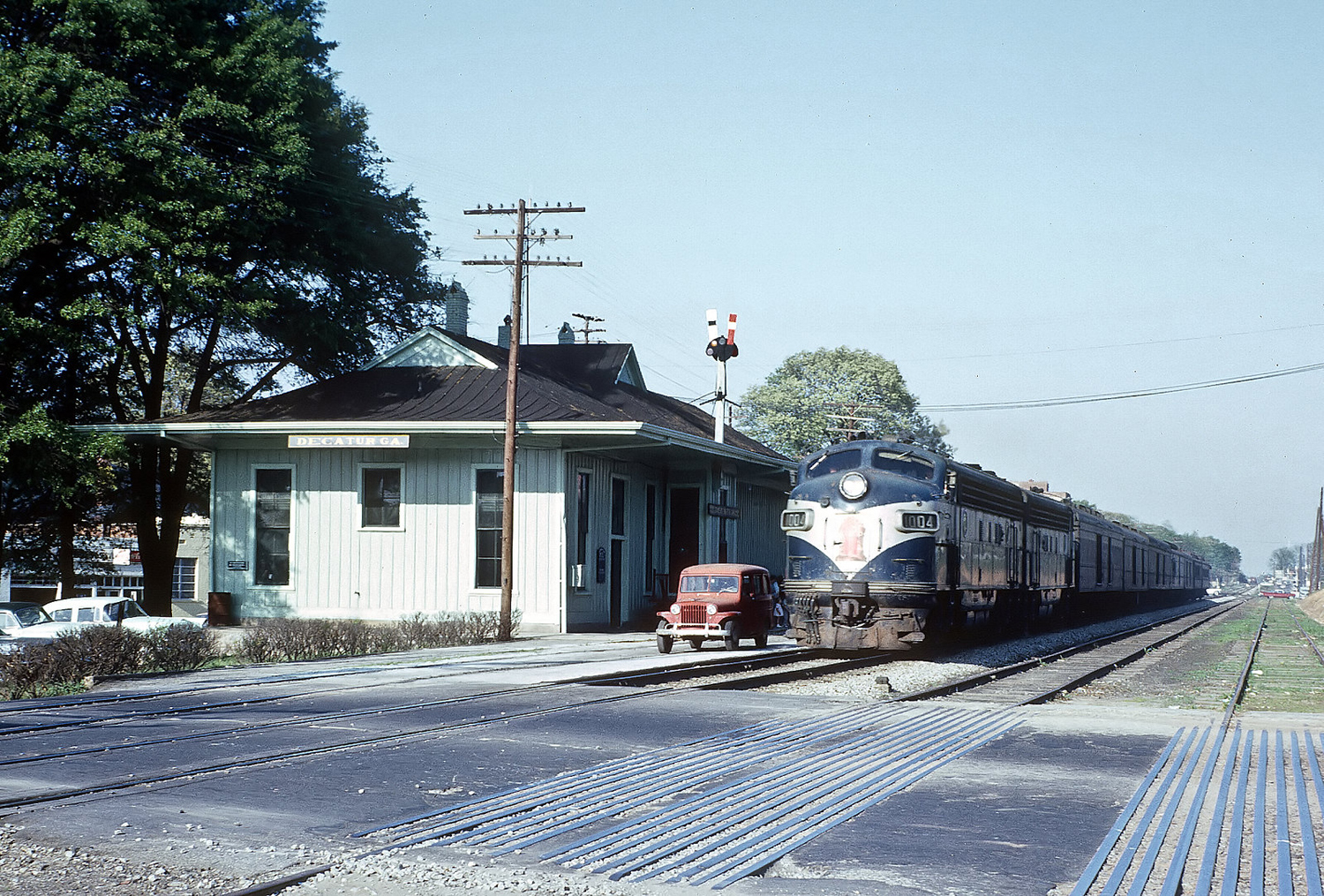 Georgia Railroad FP7 #1004 has train #1, the westbound "Palmetto," arriving at Decatur, Georgia on April 12, 1963. Roger Puta photo.
Georgia Railroad FP7 #1004 has train #1, the westbound "Palmetto," arriving at Decatur, Georgia on April 12, 1963. Roger Puta photo.The roads also received a series of sleek, stainless-steel lightweight cars for Southern's Crescent including an RPO-Baggage-Express, coaches, a diner, pair of sleepers, and a sleeper-observation.
Into the 1960's the West Point Route canceled as many passenger trains as it could due to the declining nature of this business.
It was further hurt by the U.S. Post Office discontinuing mail contracts, which made their final runs on October 18, 1966. By 1968 only the Crescent remained and its final remnants were dropped entirely after January 7, 1970.
Second-generation road power began arriving at this time and new GP models continued arriving throughout the 1970's carrying a simplified solid black livery with only the company logos and names on the carbody.
Family Lines and CSX Transportation
That decade also witnessed each railroad's identity disappearing into the Family Lines System. In 1974 the West Point lost its separate traffic and accounting departments which were folded into the owning railroads.
As the Seaboard Coast Line, Louisville & Nashville, and other Family Lines properties continued consolidating operations corporate identities largely disappeared except for their respective names.
In 1980 the Family Lines completed a merger with Chessie System, which formed CSX Corporation on November 1st, a holding company.
On December 29, 1982 the group was formally merged into Seaboard System and the West Point Route officially disappeared a few days later on January 1, 1983.
Contents
Recent Articles
-
Murder Mystery Train Rides: A Complete Guide
Apr 30, 25 11:55 PM
Murder mystery dinner train rides have been a popular type of train excursion for many years. Find out where these trips can be found. -
Louisiana Interurbans and Streetcars: History, Lines, Photos
Apr 30, 25 09:42 PM
In spite of its location in the Deep South, Louisiana contained a small handful of electrified streetcar systems, including New Orleans which is still in operation today. -
Delaware Interurbans and Streetcars: History, Lines, Photos
Apr 30, 25 02:33 PM
Delaware's Mid-Atlantic location allowed for a handful of local streetcar and interurban systems to develop.
